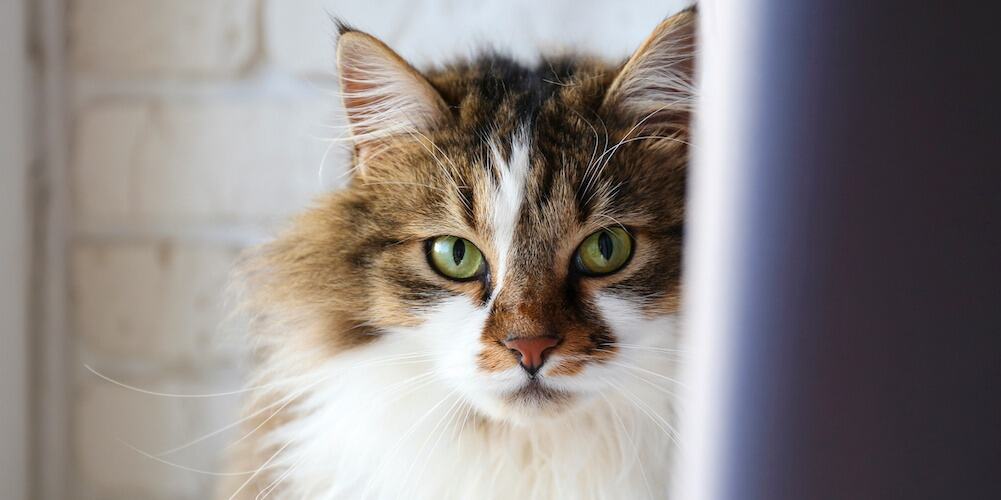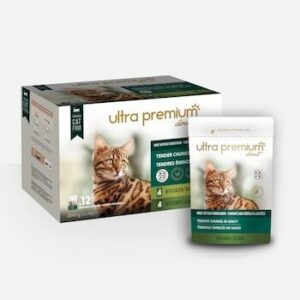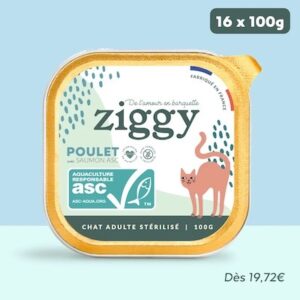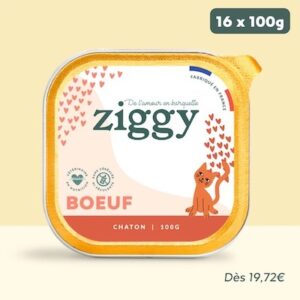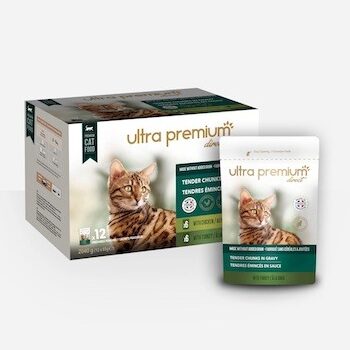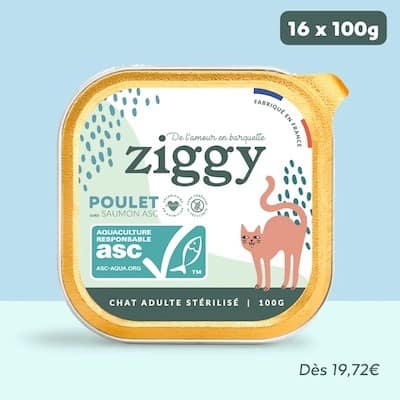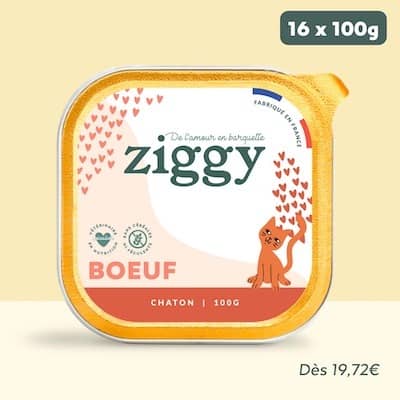We analyzed 13 brands of cat food and selected 3 products.
All the cat foods we selected are entirely manufactured in France, grain-free, and meet the recommended nutritional intakes.
Our selection criteria
- % proteins: this refers to the protein content of the cat food. It should be at least 10%.
- % fats: this refers to the fat content of the food. It should be limited for sterilized and/or overweight cats.
- PPR: the protein-to-phosphate ratio is a good indicator of the proportion between meat and carcass. The higher it is, the better.
- Price / 100 g: this is the price for 100 g of cat food.
- Customer reviews: this average of customer reviews on the brand comes from the brand’s website, review platforms, or marketplaces like Amazon.
BEST QUALITY / PRICE RATIO
Brand: Ultra Premium Direct
% proteins: 9.5%
% fats: 4.5%
PPR: 79.2
Price / 100 g: €0.73
Customer reviews: 4.7/5 (avis-verifies.com)
We selected this food for sterilized cats for its nutritional composition quality and its excellent quality/value ratio.
The protein content and PPR indicator are good, and the fat percentage is particularly low.
This cat food manufactured in France contains chicken and turkey and comes in freshness pouches. It is suitable for all cats, sterilized or not.
Ultra Premium Direct is a recognized French company in the pet food market founded in 2014. This brand democratized access to high-quality cat food by eliminating intermediaries between the factory and the consumer.
By subscribing, you get a 10% discount.
BEST HIGH END
Brand: Ziggy
% proteins: 10%
% fats: 6%
PPR: 109.6
Price / 100g: €1.45
Customer reviews: 4.8/5 (ziggy-family.com)
The Ziggy brand offers a food for sterilized adult cats with an excellent nutritional profile.
It presents the highest protein-to-phosphate ratio in our comparison, indicating the use of good quality meat cuts with minimal bones and cartilage.
Made with chicken, pork, and ASC-certified salmon fillets (responsible aquaculture), this food contains 10% protein and low fat. It is thus suitable for sterilized cats, and more broadly for cats with a tendency to gain weight.
Ziggy is a young cat food brand based in Bordeaux. All products are made in France, with recipes developed by a world-renowned veterinary nutritionist known for her expertise in clinical nutrition.
By subscribing, you receive a 15% discount and €10 off the first month.
BEST KITTY FOOD
Brand: Ziggy
% proteins: 11.3%
% fat: 10%
PPR: 84.9
Price / 100 g: €1.45
Customer reviews: 4.8/5 (ziggy-family.com)
The kitten pâté from the Ziggy brand is an excellent choice considering the quality of the ingredients used and its nutritional profile.
It is very high in proteins (11.3%) and has a fat content suitable for this stage of life.
Enriched with vitamins and minerals, this beef pâté is suitable for kittens from weaning up to 12 months.
Ziggy is a young cat food brand based in Bordeaux. All products are made in France, with recipes developed by a world-renowned veterinary nutritionist known for her expertise in clinical nutrition.
By subscribing, you receive a 15% discount and €10 off the first month.
What are the benefits of wet cat food?
Cat pâté is a complete industrial food that contains all the nutrients necessary for your pet’s good health.
When it is of good quality, it is a guarantee of longevity and well-being for your companion.
The key difference between kibble and cat pâté is their water content: less than 14% for dry food versus 70 to 80% for wet food.
READ ALSO | Best cat kibble: our buying guide
Cat food ensures better urinary health
The cat is an animal that drinks little. Consequently, its urine is very concentrated and tends to “sediment,” forming either stones or small magmas composed of minerals and proteins.
This can result in cystitis and, particularly in males, serious urinary obstructions.
This phenomenon is even more accentuated in animals fed exclusively on kibble due to the negligible moisture content of this food.
Canned food with over 70% water content allows for better hydration and beneficial dilution of urine.
It is now considered dangerous to feed a cat exclusively with dry food.
The water contained in wet cat food contributes to your companion’s urinary health and well-being by preventing painful conditions, and stressful consultations and hospitalizations!
Wet cat food allows for better satiety
Due to its larger volume, pâté promotes a better filling of the stomach, which sends a message of satiety to the brain, stopping hunger sensations, and thereby food intake.
An interesting property for limiting overweight in sedentary and neutered animals.
This point is far from anecdotal, as about one in three cats suffers from obesity, a condition involved in many diseases (diabetes, hepatic lipidosis, osteoarthritis, lower urinary tract disease…).
A wide variety of options
Whether in terms of texture or flavor, your kitty will be spoiled for choice!
Indeed, you can find actual pâté but also chunks, minces, mousses, stews, terrines…
There is also something for all tastes, from classic “chicken” to more iodized “seafood” and even the gentle “rabbit”!
Better palatability
The strong smell and more pronounced taste of wet cat food do not leave our little gourmets indifferent.
This quality can be used to feed a weak or elderly cat or simply a picky eater.
An interesting mix with kibble
Finally, cat cans are the ideal complement to a dry diet.
The kibble/pâté mix is the diet that best respects both the dietary and behavioral needs of the cat.
Currently, the mix recommended by veterinary nutritionists is a bit of pâté in the morning and evening for hydration and taste, and a few kibbles throughout the day for snacking and oral health.
Regarding quantities, they vary according to brands, compositions, and the cat’s weight. It’s best to refer to the packaging.
As an indication, Hill’s recommends 300 g/day for a 4 kg adult cat, or 85 g + 40 g of kibble. The goal is to maintain the animal’s ideal weight.
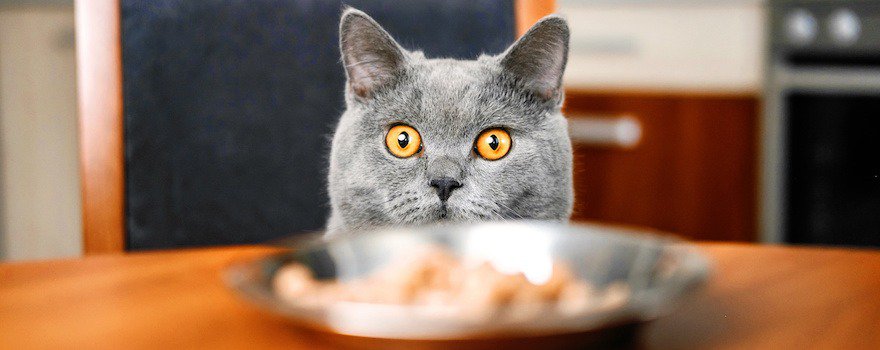
What criteria should be considered when buying cat pâté?
It is not always easy to find your way through the many pet food brands. Here are some tips to choose your cat pâté wisely.
The composition
The cat, being a strict carnivore, requires a diet rich in protein. But not just any kind; it’s important to prioritize animal-based proteins such as meat, fish, or eggs.
Quality proteins provide the eleven essential amino acids that cannot be synthesized by the cat’s body, like taurine, whose deficiency can lead to heart problems.
The protein content in a can should be between 7 and 15% (this range is due to moisture level variation)
Other ingredients include vegetables in small amounts, fats including fatty acids (for the beauty of the coat in particular), vitamins, and minerals (calcium, sodium, phosphorus, potassium, magnesium) in moderation.
In practical terms, on the labels, you should look for the following percentages:
- A high protein content, over 7%
- A low carbohydrate (sugar) content, below 2%
- A fat (lipid) content around 5%
- A crude fiber content below 1.5%
- A crude ash (mineral) content below 2.5%, with a phosphorus content below 1.1%
- A protein-phosphorus ratio above 35
This last point, the protein-phosphorus ratio or PPR (which you will need to calculate yourself; it is the percentage of protein divided by the percentage of phosphorus in the food) is a good indicator of the quality of the proteins included in cat food.
Indeed, high-quality protein ingredients (meat, fish…) have a high PPR. Whereas low-end ones (carcasses, bones, cereals…) have a low PPR.
The phosphorus content is usually indicated on the labels of serious pet food brands.
Health Standards
Wet food is more perishable than dry food. It must meet precise manufacturing standards and be subject to regular inspections.
To know if the manufacturer complies with current regulations both nutritionally and health-wise, you can ensure they are a member of FEDIAF (European Pet Food Industry Federation) or FACCO (Federation of Manufacturers of Pet Food for Dogs, Cats, Birds, and other pets).
Pet food manufacturers who are members of these organizations commit to observing a code of good practice.
Once opened, cat cans should be stored in the refrigerator for a maximum of 2-3 days. However, they may lose palatability…
Price
Low price, beware. Good ingredients are expensive ! Quality wet food is not cheap.
Professional Advice
If you are lost, do not hesitate to seek advice from your veterinarian, who knows the pet food market, and, most importantly, knows your cat!
Industrial food allows for a near-personalized diet depending on the age and health status of your cat.
You will find special kitten or senior cans, as well as pâtés to help an overweight animal lose weight or to soothe a cat suffering from digestive or skin sensitivity.
Veterinary brand manufacturers also market wet food for cats suffering from kidney failure or diabetes, for example.
What are the best kitten pâtés?
The kitten (1 to 8 months) is an animal in full growth. It has specific nutritional needs to ensure its development.
Kitten cans are richer in protein, contain more calcium, and are higher in calories.
Wet food suitable for very young kittens (1 month) is available at the time of dietary diversification.
There are also cans for sterilized kittens (around 6 months).
They allow the animal to finish growing harmoniously without gaining excessive weight thanks to a reduced fat content.
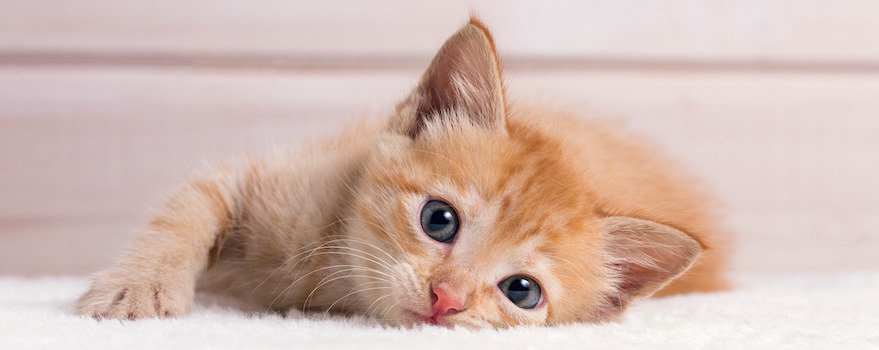
What are the best pâtés for sterilized cats?
Male and female cats are generally sterilized around 6 months old.
Sterilization leads to hormonal changes. Combined with a certain sedentariness (cats going out little or not at all), it can promote weight gain.
If not careful, this excess weight can lead over the years to obesity. That’s why manufacturers have designed specific foods for sterilized cats.
These neutered cat foods are characterized by a reduced fat content and the addition of fiber for satiety.
As an example, for the same range, the lipid content can vary from 5.2% for classic cans to 3.4% for the sterilized cat version. Crude cellulose (fiber) increases from 0.6% to 1.1%.
Where to buy cat food?
You have different channels to obtain cat food.
At veterinarians
They offer premium veterinary-specific ranges. You can shop there with confidence.
Some clinics offer online stores with reduced prices and a click-and-collect system.
In pet stores
They sell different brands, including those found in veterinary clinics, and also have online stores.
In supermarkets
The quality varies. It is preferable to avoid low-cost ranges. As we have seen above, good ingredients are expensive!
Online
The choice is very vast, with both good and less good options.
Online, it can sometimes be difficult to navigate, and relying on attractive packaging or well-crafted marketing arguments is not always wise.
Before ordering, check the reliability of the site and its country of origin. Standards are not the same in all countries.
Also, consider your carbon footprint when ordering cans manufactured on another continent!
You can also look for quality labels such as the manufacturer’s membership in FEDIAF or FACCO.
Are cans responsible for cat diarrhea?
Because of its high water content, wet food is sometimes accused of causing diarrhea.
Quality food should not present this kind of problem, whether it’s dry or wet.
An episode of loose stools following the introduction of cat food can result from:
- A dietary transition that is too rapid
- Poor quality or poorly stored cans
- An underlying condition; if diarrhea persists after stopping the new food, it is advisable to consult a veterinarian
In summary
A quality wet cat food:
- Is rich in animal-origin proteins
- Has a RPP above 35
- Has one or more quality labels
- Has a reduced fat percentage if your cat is sterilized
- Can be mixed with kibble!
- Is preferably bought in a specialized circuit
When you purchase the selected products, a commission may be paid to us, helping to keep the site running, compensate our writers, and ensure quality information for you. This does not affect prices.


